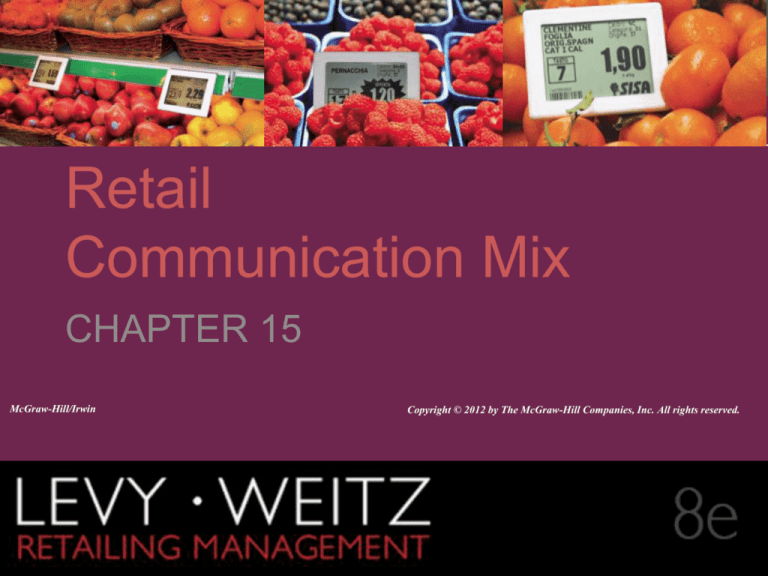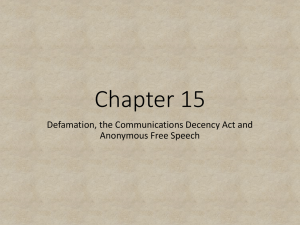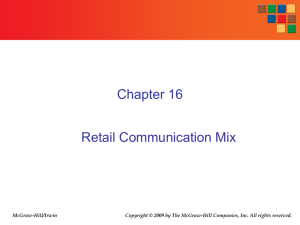
CHAPTER
CHAPTER15
2
1
Retail
Communication Mix
CHAPTER 15
McGraw-Hill/Irwin
Retailing Management 8e
Copyright © 2012 by The McGraw-Hill Companies, Inc. All rights reserved.
© The McGraw-Hill Companies, All rights reserved.
15 -
Brands
CHAPTER
CHAPTER15
2
1
Distinguishing name or symbol, such as a logo,
that identifies the products or services offered by
a seller and differentiates those products and
services from those offered by competitors
The McGraw-Hill Companies, Inc./John Flournoy, photographer
The McGraw-Hill Companies, Inc./Bob Coyle, photographer
15 -
Value of Brand Image
CHAPTER
CHAPTER15
2
1
Brands
Value to Retailers (Brand
Equity)
•Attract Customers
•Build Loyalty
•Higher Prices Leading to
Higher Gross Margin
Value to Customers
•Promises Consistent Quality
•Simplifies Buying Process
•Reduces Time and Effort Searching
for Information About
Merchandise/Retailer
•Reduced Promotional Expenses
•Facilitates Entry into New Markets
Gap GapKids
15 -
Building Brand Equity
CHAPTER
CHAPTER15
2
1
15 -
Benefits of High Brand Awareness
CHAPTER
CHAPTER15
2
1
15 -
Creating Brand Awareness
CHAPTER
CHAPTER15
2
1
Memorable
Name
Best Buy
Repeated
Exposure
Home Depot
Top-of-mind
Brand Awareness
Starbuck’s
Symbols
Macy’s
Event
Sponsorship
15 -
Consistent Reinforcement through Integrated
Marketing Communication Program
CHAPTER
CHAPTER15
2
1
Integrated Marketing Communication Program
•A program that integrates all of the communication
elements to deliver a comprehensive, consistent
message
•Providing a consistent image can be challenging for
multichannel retailers – Need to consider the needs
of all channels early in the planning of its
communication program
15 -
Integrated Marketing
Communications
CHAPTER
CHAPTER15
2
1
• Present a Consistent Brand Image through all
Communications with Customers
•Store Design
•Advertising
•Web Site
•Magalog
The McGraw-Hill Companies, Inc./Andrew Resek, photographer
15 -
Brand Extensions
CHAPTER
CHAPTER15
2
1
• Gap GapKids and Old Navy
• Abercrombie & Fitch Hollister and Gilly Hicks
• Sears Sears Auto Centers and the Great Indoors
• Pottery Barn Pottery Barn Kids
The McGraw-Hill Companies, Inc./Andrew Resek, photographer
15 -
Methods of
Communicating with Customers
CHAPTER
CHAPTER15
2
1
15 -
Direct Marketing
CHAPTER
CHAPTER15
2
1
15 -
Online Marketing
CHAPTER
CHAPTER15
2
1
15 -
Social Media
CHAPTER
CHAPTER15
2
1
15 -
Public Relations (PR)
CHAPTER
CHAPTER15
2
1
• Managing communications and relationships to achieve
various objectives
• Building and maintaining a positive image of the retailer
• Handling or heading off unfavorable stories or events
• Maintaining positive relationships with the media
• In many cases, public relations activities support other
promotional efforts by generating “free” media attention and
general goodwill.
15 -
Planning the
Retail Communication Program
CHAPTER
CHAPTER15
2
1
15 -
Establish Objectives
CHAPTER
CHAPTER15
2
1
• Communication objectives:
• Specific goals related to the retail communication
mix’s effect on the customer’s decision-making
process
• Long-term: ex. creating or altering a retailer’s
brand image
• Short-term: ex. increasing store traffic
15 -
Determine the Communication
Budget
CHAPTER
CHAPTER15
2
1
• Marginal Analysis Method
• Based on the economic principle that firms should
increase communication expenditures as long as
each additional dollar spent generates more than
a dollar of additional contribution
• Very hard to use because managers don’t know
the relationship between communication
expenses and sales
15 -
Objective-and-Task Method
CHAPTER
CHAPTER15
2
1
• Determines the budget required to undertake
specific tasks to accomplish communication
objectives
15 -
Rule of Thumb Methods
CHAPTER
CHAPTER15
2
1
• Affordable Budgeting Method – sets communication budget
by determining what money is available after operating costs
and profits are budgeted.
• Drawback: The affordable method assumes that the
communication expenses don’t stimulate sales and profits.
• Percentage of Sales Method – communication budget is set
as a fixed percentage of forecasted sales.
• Drawback: This method assumes the same percentage
used in the past, or by competitors, is still appropriate for the
retailer.
15 -
Allocate the Promotional Budget
CHAPTER
CHAPTER15
2
1
• The retailer decides how much of its budget to
allocate to specific communication elements,
merchandise categories, geographic regions, or
long- and short-term objectives
• Budget allocation decision is more important budget
amount decision
High-assay principle: The retailer allocate the
budget to areas that will yield the greatest return
15 -









